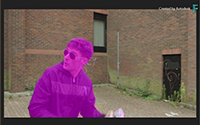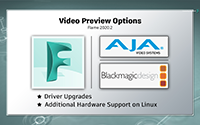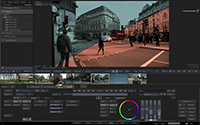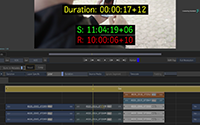Welcome to the 2020.2 Update release of the Flame Family applications!

|
Using machine learning algorithms, this new semantic keyer provides a way to isolate human bodies and heads. Use the Human Body and Human Head semantic keyers in an Image node in the Effects tab for a fast, iterative Color Grading and light FX treatments on many shots. Or use them for compositing in a full procedural Batch. See Action & Image. |

|
Flame, Flame Assist, and Flare now support Blackmagic Design UltraStudio and DeckLink SDI & HDMI Preview cards on CentOS. See AVIO. |

|
You can now store unlimited reference stills, in a new, improved compare tool. |
Additional information:
- Many new feature videos workflow videos are available on the
Flame Learning Channel. This channel is updated frequently, make sure to subscribe.
This icon indicates links to videos:

- In this What's New topic,
 indicates a new feature or enhancement that was suggested and voted up by Flame Family users on the
Feedback portal (also accessible directly from
).
indicates a new feature or enhancement that was suggested and voted up by Flame Family users on the
Feedback portal (also accessible directly from
).
- Make sure to check out Flame Central, the hub for all your Flame family links.
- Looking for the Release Notes for Flame Family 2020.2 Update? Click here: Flame Family 2020.2 Update Release Notes.
Welcome Screen
Want to get only the highlights of the release? The Welcome Screen shows what's new, and opens the first time you launch a Flame Family product.
Or access it anytime from .
For details on all the new features and enhancements in this release, follow these links:
- Action
- Action & Image
- Archive
- AVIO
- Batch
- Burn-In Metadata
- Comparing to References
- Conform
- Effects Tab
- Keyboard Shortcuts
- License Manager
- Matchbox
- Media Export
- Media Import
- Player
- Python API
- Tangent Control Panels
- Timeline
Action
 From object to geom.
You can now convert 3D Text and 3D Shape objects into regular geometries. You can then export these geometries to the FBX format. For more details, see
3D Shape to Geometries and
3D Text to Geometries.
From object to geom.
You can now convert 3D Text and 3D Shape objects into regular geometries. You can then export these geometries to the FBX format. For more details, see
3D Shape to Geometries and
3D Text to Geometries.
Import and Replace. You can now replace an imported FBX or Alembic geometry with another one without losing the current connections: use the new option Import and Replace in the contextual menu. For more details, see Replacing a 3D Model with another.
From Working to Perspective. The Action Working Camera changes name for Perspective Camera. The newly named Perspective Camera is now displayed in the Action Manager (under Camera). Use the Manager to see and edit its parameters. You cannot animate the Perspective Camera, nor delete it. To animate the Perspective camera, or to preserve its current settings, create a Camera node by duplicating the Perspective Camera node.
Updated FBX and PBR models updates. The FBX models included with Action are now sorted and grouped into folders. This organization makes for shorter file names, making it easier to browse and identify each model. Similarly, the included PBS assets are now grouped into a Quads and a Triangles folder. In this case, each model exists in both format, allowing you to pick the best model for your situation. Finally, we've refreshed some models' UV layout, and added Pole and NoPole versions of some models.
More nodes with expanded UI. The following nodes can now use the expanded UI. Some had their UI updated to standardize some terms.
- 3D Text
- 3D Shape
- Geometry
- Particle Generator
- FBX Scene
- ABC Scene
Substance PBR. Now with cataphote. We added the following 20 Substance PBR presets to the texture library.
Ground
- asphalt_fine_cracked
- cement_grout
- concrete_raw_soft
- concrete_worn_scratched
- cracked_asphalt
- moon_crater
- powdery_snow_marks
Man-made
- carbon_fiber_plain_weave
- crackling_lime
- oled_dashboard_screen
- tire_rubber_ridged
Metal
- car_iridescent_paint
- car_solid_paint_wet
- metal_perforated_triangles
- painted_metal_chipped
Organic
- eye_blue_bulbar_conjonctiva
- female_40yo_cheek_skin_1
- male_30yo_cheek_skin_1
Translucent
- cataphote_rear_reflector_wave
- mirror_dirty
Action Shader: Thin Film
Use the new Thin Film controls to create iridescence effects. Use it with plain colours or a material like multitone car paint. For more details, see Thin Film settings.
Action & Image

|
 Human Body and Head Semantic Keyers Human Body and Head Semantic Keyers
|
The Selective node has two new semantic keyers and new widgets for the 3D AOV Primitive mode.
- Semantic keyers. The Human Body keyer isolates human bodies in a clip, while the Human Head keyer isolates heads. Use the Selected mode together with the Object View to isolate a specific body or head. For more details, see Semantic keyers settings.
- Primitive. The 3D AOV Primitive mode now displays, in the Object View, an interactive widget. Use this widget to segment specific volumes in the z-depth. For more details, see Using primitives.
Archive
You can now name you archive session when using the flame_archive command line tool. For more details, see Naming an archiving session.
Back to TopAVIO

|
 AJA and Blackmagic Design Support AJA and Blackmagic Design Support
|
AJA Support
Flame Family 2020.2 Update supports the AJA 15.2 drivers.
- CentOS: Installing the DKU 14.2.0 automatically installs the AJA 15.2 drivers.
- macOS: Download the AJA Software Installer v15.2.5 - Mac from the AJA website.
Blackmagic Design Support
macOS. On macOS, you can now update the Blackmagic Design Desktop Video to version 11.4.1.
- This update is required to use a Blackmagic Design DeckLink and UltraStudio card.
- Download the Desktop Video 11.4.1 macOS package from Blackmagic Design Support Center.
- Desktop Video 11.4.1 is compatible with previous version of Flame Family on macOS.
 CentOS. On CentOS, you can now use Blackmagic Design cards with Flame, Flame Assist, and Flare on CentOS 7.2 and 7.4.
CentOS. On CentOS, you can now use Blackmagic Design cards with Flame, Flame Assist, and Flare on CentOS 7.2 and 7.4.
We've certified the Blackmagic Design UltraStudio 4K Extreme (with the PCI Express Cable Kit) and the DeckLink 4K Extreme. Other UltraStudio and DeckLink cards should work but are not certified.
For installation instructions, see the Configuration guide.
For supported timings, see Broadcast Monitor Supported Timings: Blackmagic Design.
Batch
GMask Tracer update. You now have access to the Deform Mesh node and the Magnet Tool in the GMask Tracer.
Burn-In Metadata

|
 Burn-in Metadata - Part 1 Burn-in Metadata - Part 1
|
 Designate any one track to be the source of metadata information used by every Burn-In Metadata present in that version.
Designate any one track to be the source of metadata information used by every Burn-In Metadata present in that version.
 Use the new Duration layer to display the duration of different objects.
Use the new Duration layer to display the duration of different objects.
 Propagate the Clip and Segment colours to the Text and Background of a layer in the Timeline FX and module.
Propagate the Clip and Segment colours to the Text and Background of a layer in the Timeline FX and module.
 In the Frame layer, start the frame count from the head frame instead of the segment start with the new Consider Head button.
In the Frame layer, start the frame count from the head frame instead of the segment start with the new Consider Head button.
 In the Resolution layer, control the decimal precision of the aspect ratio with the new Precision field.
In the Resolution layer, control the decimal precision of the aspect ratio with the new Precision field.
Editing the ribbon. You can now use the Timeline Tab's TimelineFX Ribbon to edit the Burn-In Metadata settings.
Looking past the gap. The Timeline FX placed over a gap now reads the information from the background layer instead of itself when there is nothing below the gap.
For more details, see Burn-In Metadata.
Back to TopComparing to References

|
 Comparing Images Comparing Images
|
How you compare a frame to a reference image changes in 2020.2 Update.
 Permanent references. Grabbed references are now stored in the Grabbed References library, a new library in the Media Panel. This library is hidden, unless you enable
.
Permanent references. Grabbed references are now stored in the Grabbed References library, a new library in the Media Panel. This library is hidden, unless you enable
.
You can rename, sort, delete references from the Grabbed References library.
 UI Update. The Compare Modes box replaces the Compare toggle in Batch, Effects, and Tools' viewing area. It offers the following modes:
UI Update. The Compare Modes box replaces the Compare toggle in Batch, Effects, and Tools' viewing area. It offers the following modes:
- Angle Split
- Blend
- Difference
- Grid
Screen Grab and Rename. You can now name a reference as you're grabbing it, or let the software do the naming for you.
Select References. You now select the reference to compare to from the Reference box.
Edit Compare Modes. Use the new Edit Compares Modes window to edit the settings of the different compare modes.
Keyboard shortcuts. You can edit some of the compare modes directly from the viewport using keyboard shortcuts. Use keyboard shortcuts to edit the different compare modes, or to cycle through them.
 Compare Modes Updates. The Difference mode in the Player and Viewports is updated.
Compare Modes Updates. The Difference mode in the Player and Viewports is updated.
- The Difference mode unifies the old Diff and Diff Clamped modes.
- The Difference mode provides Gain and Lift settings.
For more details, see Comparing to References.
Additional improvements
- Compare full screen. The Compare / Stereo buttons available in the Player's Viewing Settings panel are now available in the Fullscreen Player.
- Primary and Secondary from context. You now set the primary and secondary tracks from the Timeline track's contextual menu.
Conform
Support for AAF sequence from Avid Media Composer 2019. Media Composer 2019 can generate MXF OpAtom and Op1a cached media. You can now import these media files in Flame Family products.
Back to TopEffects Tab
Going to the Effects tab is now faster when no Viewport is set to a context view. The drawback is that selecting a context view for the first time within the Effects tab now takes longer than before.
Back to TopKeyboard Shortcuts
 The
Slow Drag Increment and
Fast Drag Increment keyboard shortcuts are changing. Instead of changing only the speed at which the value inside a numeric field is modified, they now also change the stepping of the decrement / increment.
The
Slow Drag Increment and
Fast Drag Increment keyboard shortcuts are changing. Instead of changing only the speed at which the value inside a numeric field is modified, they now also change the stepping of the decrement / increment.
- Slow Drag Increment: The default decrement is divided by 10. For example, a decrement of 0.1 becomes 0.01 using the keyboard shortcut. It is now easier to make fine adjustments.
- Fast Drag Increment: The default increment is multiplied by 10. For example, an increment of 0.1 becomes 1.0 using the keyboard shortcut. It is now easier to make coarse adjustments.
License Manager
You can now easily change your license server information using Flame Setup. For more details, see Changing the license server information.
Back to TopMatchbox
Two new Matchboxes are now available, one for extracting human bodies from a clip, another for human heads.
- MLHumanBodyExtraction to extract whole human body shapes.
- MLHumanHeadExtraction to extract human heads.
Both Matchboxes are similar to the two new Semantic Keyers now available in the Action/Image section.
Back to TopMedia Export
Colour spaces in more formats. PQ and HLG colour spaces are now supported when exporting content as H.264 (.mov) and Sony XAVC (.mxf) formats.
IMF Update - Dual Sound fields Audio Track Mapping Options
You can now create an IMF package with dual sound fields audio tracks and produce 5.1 and 2.0 (stereo) deliverables.
The IMF for Netflix built-in presets have been updated to produce 5.1 and 2.0 audio media. For more details on IMF, see Publishing a Distribution Package Using IMF.
New AVC HD 2.0 and Panasonic Professional H.264/AVC Export Presets
The following presets are now available in 2020.2 Update.
| Preset Description | Export Preset |
|---|---|
| AVC HD 2.0: encode AVCHD 50 p and 59.94 p content. | QuickTime (AVC HD 2.0 1080p) |
| Preset Description | Export Preset |
|---|---|
| AVC Ultra: High quality 10-bit encoding for HD (1080i/p and 720p), 2K, UHDTV, and 4K formats (23.98 fps, 25 fps, 29.97 fps, 50 fps, and 59.94 fps). |
|
| LongG: 8-bit LonG (LongGOP) Panasonic HD formats (1080i/p and 720p) (23.98 fps, 25 fps, 29.97 fps, 50 fps, and 59.94 fps) |
|
| Panasonic P2 HD formats (1080i/p and 720p) (23.98 fps, 25 fps, 29.97 fps, 50 fps, and 59.94 fps). |
|
| Panasonic RP 2027 HD formats (1080i/p and 720p) (23.98 fps, 25 fps, 29.97 fps, 50 fps, and 59.94 fps). |
|
Media Import
Faster pattern browsing. Improved performance when using Pattern Browsing with long content. In previous releases, changing version could take a long time.
Updated ARRIRAW decoding. Flame Family products now support ARRIRAW SDK 6.2. This SDK provides:
- Faster GPU debayering for native and resized resolutions (CentOS only).
- Fast resizing when resize options do not change the aspect ratio of the resulting image.
- Support for ARRI ALEXA Mini LF
 Support for Apple ProRes MXF (OpAtom) generated by Avid Media Composer.
Content transcoded and consolidated to MXF in Avid Media Composer using the following Apple ProRes compressions can now be imported in Flame Family products:
Support for Apple ProRes MXF (OpAtom) generated by Avid Media Composer.
Content transcoded and consolidated to MXF in Avid Media Composer using the following Apple ProRes compressions can now be imported in Flame Family products:
- Apple ProRes 422 Proxy
- Apple ProRes 422 LT
- Apple ProRes 422
- Apple ProRes 422 HQ
- Apple ProRes 4444
- Apple ProRes 4444 HQ
Updated codec profiles. The following H.264 encoding/decoding profiles were updated:
- AVCHD 2.0
- Intra High 10
- Intra RP2027 Class50
- Intra RP2027 Class100
- Intra RP2027 Class200
- P2 2K Intra 422
- P2 4K Intra 422
- P2 HD Intra 422
- P2 LONG GOP 420 Class G6
- P2 LONG GOP 420 Class G12
- P2 LONG GOP 422 G25
- P2 LONG GOP 422 G50
Better playback. You should see improved performance when playing back Panasonic Varicam LT (.mxf) clips.
Memory Management. Flame Family products are now more efficient at managing available memory when working with ARRIRAW and R3D files.
GPU Import Pipeline. GPU processing is now available for the following operations when importing media (MediaHub and Import/Read File nodes)
- Resizing
- Colour Management
The GPU import pipeline improves playback performance when reading uncached media files with Resizing and Colour Management options.
Essence Mode has moved. The Essence Mode button is now at the root of MediaHub, in the General Options tab. Essence Mode used to be located in the Browsing section of each format. The new location at the root of MediaHub makes it easy to enable essence mode when browsing folders containing media files of different formats.
 CODEX HDE Support
CODEX HDE Support
You can now use Flame Family products to decode CODEX High Density Encoding (HDE) for the ARRIRAW format. With this new format support, you can:
- Import CODEX HDE encoded ARRIRAW media files (.arx). These encoded files are seen as ARRIRAW media files when decoded.
- Experience better playback performance since compressed media files are read faster from storage.
For more information about CODEX HDE, see CODEX FAQ.
Sony MXF Improvements
- Support for Colour Space data from Sony XAVC and SStP MXF content.
- In previous version, Sony MXFColour Space data was seen as Unknown. Now, when MediaHub Colour Management option is set to Use File or Rules, the content colour space matches the colour space of the file.
- Camera metadata is now available in .
- A card containing multiple formats (SStP with XAVC) is now supported.
Player
The Compare / Stereo tools and the In / Out / Duration controls are now available in the Full screen Player.
Back to TopPython API
Improvements to the Python API:
New attributes
- Attributes for the Comp and Burn-In Letterbox Timeline FX can now be modified on a timeline segment.
New Timeline FX functions:
 <PyTimelineFx>.save_setup(): Used to save a Timeline FX setup.
<PyTimelineFx>.save_setup(): Used to save a Timeline FX setup.
-
 <PyTimelineFx>.load_setup(): Used to load a Timeline FX setup.
<PyTimelineFx>.load_setup(): Used to load a Timeline FX setup.
- Python functions can now be executed asynchronously at an undetermined time in Flame's idle loop using the flame.schedule_idle_event() method.
For more details, see the Python API.
Back to TopTangent Control Panels
CentOS: Installing Flame Family 2020.2 Update on CentOS automatically updates the Tangent Control Panels to version 1.5.2-2.
macOS: You need to manually download and install the updated Tangent control panel software directly from the Tangent website.
Back to TopTimeline
 You can now create a Batch Group from the Timeline without also creating the matching destination timeline segment. To stop creating a batch group, enable
.
You can now create a Batch Group from the Timeline without also creating the matching destination timeline segment. To stop creating a batch group, enable
.
- Enable Add Destination Segment to add a destination segment to the timeline for each Batch Group you create. The behaviour seen in previous releases.
- Disable Add Destination Segment to create a Batch Group without the matching destination segment; the new option.
If you disable Add Destination Segment:
- Smart Replace becomes unavailable in the Render node: you insert manually the rendered clip back into the timeline.
- You can now create a Batch Group from any clip: the clip doesn't have to be in a Reel Group.